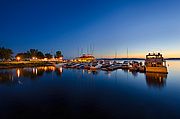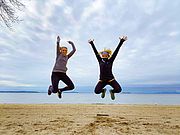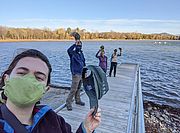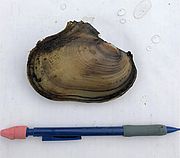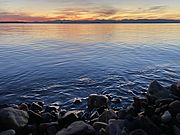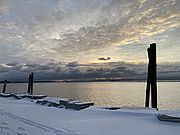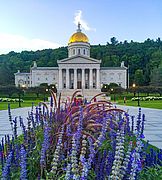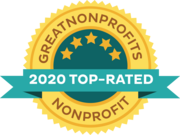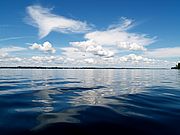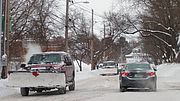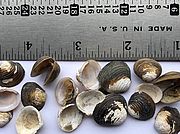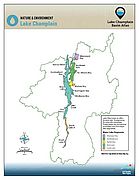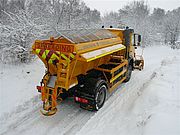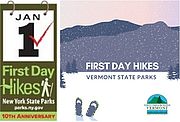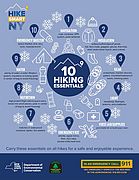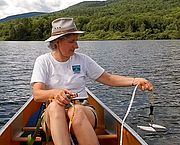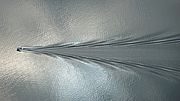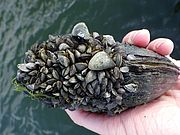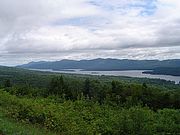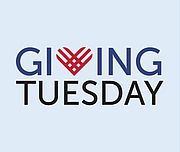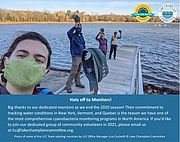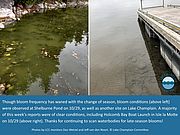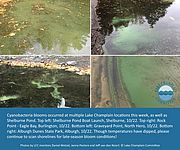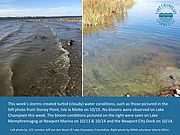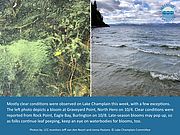Out of concern for Lake Champlain’s underwater ecosystems, the Lake Champlain Committee (LCC) and the Vermont Natural Resources Council (VNRC) have appealed a permit issued by the Agency of Natural Resources (ANR) to allow the sinking of a 152-foot-long ferry near the Burlington waterfront. Read...
News from Selected Month
Happy Earth Day! Click here to read a few ideas for how to celebrate and protect our planet and the special corner we call home from your friends at the Lake Champlain Committee. Read...
Come work for clean water! The Lake Champlain Committee (LCC) seeks a highly-organized, detail-oriented, energetic, enthusiastic, multi-tasking Office Manager to work in a fast-paced team environment with humor, computer and web savvy, and a commitment to LCC’s mission. Database management and QuickBooks experience helpful. Equal Opportunity Employer. Read...
If you’ve paddled, taken a swim, or cast a fishing line in the waterbodies of the Lake Champlain Basin, you’ve likely spent time among one of the most enigmatic and imperiled groups of aquatic animals in our region: native freshwater mussels. They’re quirky—sporting hatchet-like shells and traveling by a single fleshy foot, yet familiar—related to the invasive zebra mussel and edible bivalves such as scallops. Read...
The Global Warming Solutions Act (GWSA) turned Vermont's climate emissions reductions goals into binding requirements and led to the creation of the Vermont Climate Council. The Council is in the early stages of developing a climate action plan to ensure we meet our emissions targets, prioritize our most vulnerable communities, and build a stronger, more resilient economy. Key to that effort is bringing in additional stakeholder perspectives and issues expertise through the Council's Subcommittees (see list below). Read...
Environmental leaders applaud Governor Scott’s commitment to funding increases for Vermont’s people, environment, and
economy. The proposed 2021 budget includes a boost to weatherization funding for low- and moderate-income households;
support for clean energy and transportation options; investments in our public lands; and improvements to our downtowns and village centers. Read...
Each year, the Vermont Clean Water Network hosts a Clean Water Policy Forum focusing on legislative and regulatory issues.
Register to hear Jared Carpenter, LCC's Water Protection Advocate, talk about the latest clean water issues under consideration in the current legislative session, and updates on Clean Water Service Providers and Vermont Agency of Natural Resources budgeting. Read...
We share this message in response to recent violence and disruption to our democracy, both in our nation’s Capitol and across our country: Common Good Vermont unites nonprofits across Vermont to condemn actions of hate, violence, inciting of such actions, and disruptions to our lawful democratic processes. Vermont nonprofits stand united in opposition to the insurrection January 6th, on the U.S. Capitol, and its roots in white supremacy. Read...
The Lake Champlain Committee (LCC) strongly condemns the 1/6/21 attack on the United States Capitol. This assault on our democracy was an act of domestic terrorism. The actions were unpatriotic and unlawful. The stark contrast between how the mob of insurrectionists who vandalized the Capitol were treated and law enforcement response to peaceful Black Lives Matter protests in recent months underscores structural racism in our country. Read...
The Lake Champlain Committee (LCC) has been named a “2020 Top-Rated Nonprofit” by GreatNonprofits, the leading provider of user reviews and ratings of charities and nonprofits. The Top-Rated Nonprofit Award is based on the five-star ratings and reviews that LCC received from volunteers, donors and community members. Read...
In January of 2020, a coalition of 30 business, environmental, low-income, youth, public health, faith, and climate justice organizations including LCC identified the Global Warming Solutions Act (GWSA) as an essential priority for the 2020 Vermont legislative session. Nine months later, in late September 2020, GWSA officially became law after a veto by VT Governor Phil Scott was overridden by both the Vermont House and Senate. The legislation requires Vermont to reduce climate damaging emissions while simultaneously creating jobs, improving resilience, reducing energy burdens for rural and marginalized communities, and using natural systems to capture and store carbon. Read...
The Randy Preston Road Salt Reduction Act, a bipartisan bill that will help to reduce road salt pollution in the Adirondack Park, was signed into law by Governor Cuomo on December 2, 2020. The bill passed both houses of the New York Legislature in July with nearly unanimous support. The Adirondack Park contains more than 11,000 lakes and ponds, and over 30,000 miles of rivers, brooks, and streams. Lake Champlain forms the eastern border of the Park and a significant portion of the New York portion of the Lake Champlain Basin is within Park boundaries. Read...
Lake Champlain is home to 51 known non-native and aquatic invasive species (AIS), from zebra mussels and alewife to water chestnut and Eurasian watermilfoil, but not yet Asian clam. Invasive species are not native to the Lake Champlain Basin and can compete with native species for space and food, clog water intake pipes, and limit recreational activities. Read...
“The importance of water is often overlooked today. To the Abenaki people, water is the web of life that connects all living things together in both past, present and future generations,” states Chief Don Stevens of the Nulhegan Abenaki Tribe in the short film, Nebi: Abenaki Ways of Knowing Water. Read...
The single entity of Lake Champlain contains five distinct segments, each with its own character: the South Lake, the Main Lake, and, east of the islands, Malletts Bay, the Inland Sea, and Missisquoi Bay. Read...
Salt flavors our food and keeps our winter travels safe, but it can have a negative impact on waterways. According to the United States Geological Survey (USGS), 20 million metric tons of road salt are spread annually in the U.S.—equivalent to approximately 20 million elephants. Applying less salt to roads and sidewalks can improve the health of the Lake Champlain Basin’s waters. Read...
Atlantic salmon spawning recently came to a close in Lake Champlain. Unlike their cousins in the Pacific Ocean, Atlantic salmon don’t typically die after spawning, but instead migrate back to the lake (or ocean) to feed.
Iridescent, delicious, and culturally significant, Atlantic salmon (Salmo salar) are prized in the northeast by anglers and the general public alike. Well-oxygenated, cold, deep, and fairly clear lakes, like Lake Champlain, are its primary habitat. As the seasons transition, so do salmon. In October and November, salmon move from the depths of Lake Champlain to spawn in the streams of the Lake Champlain Basin, such as the Boquet River in New York and the Winooski River in Vermont. Read...
Start the new year on the right foot with a hike in a state park! Both New York and Vermont State Parks are inviting everyone to celebrate the start of 2021 by heading out on the trails. Read...
Winter is a great time to get outdoors and it is especially helpful and healthful during the pandemic. The cold, crisp air is exhilarating and there are no biting insects! Some of the mantras for recreating safely in winter during Covid-19 are: prepare ahead, play local, physically distance from anyone not in your household, and move on after your outing so that others can enjoy the space. Below we share excerpts from guidelines for playing outdoors safely from our friends at the New York Department of Environmental Conservation (NY DEC) and Vermont Forests, Parks and Recreation (VT FPR). Read...
We weren’t sure how many people would turn out to monitor during a pandemic that required wearing a mask at public sites and quarantining for two weeks if traveling across state lines. But turn out they did! More than 160 community members signed up to check conditions at over 150 Lake Champlain and inland waterway locations during the 2020 season. They included returning veterans, first-timers, seasonal and year-round residents, couples, families, students, and friend groups. They took on more rigorous protocols, showed up virtually for training sessions via Zoom, and faithfully filed weekly reports. Read...
We send heartfelt thanks to Angela Shambaugh, our longstanding cyanobacteria monitoring program colleague who retired in October from the Vermont Department of Environmental Conservation (VT DEC). Angela has been a key partner in the monitoring program since its inception in 2003. In the early years she assisted in lab analysis, cyanobacteria assessments, water sampling, and community outreach while working at the University of Vermont. Read...
The University of Vermont (UVM) plans to replace its aging research boat with a hybrid electric “model of seaworthy sustainability”. The quiet, low-emission vessel will be able to run on electric power for two hours and be used as a floating classroom and laboratory for lake education and science. Read...
First discovered in the southern part of Lake Champlain in 1993, zebra mussels are now found throughout the lake in shallow water areas. Juvenile and adult zebra mussels attach to any hard surface—including native freshwater mussels, the lake’s most imperiled taxa. The Lake Champlain Committee is working with Michael Lew-Smith of Arrowwood Environmental to document the impacts of the invasive zebra mussels on native mussel populations as a first step in the conservation strategy. Learn more about zebra mussel impacts from Michael and fellow biologist Mark Ferguson (Vermont Fish & Wildlife Department) in this Outdoor Radio episode on Vermont Public Radio (VPR). Read...
Both Lake George and Mirror Lake in New York experienced cyanobacteria blooms in early November 2020, the first time cyanobacteria was documented in either waterbody. The Lake George bloom was discovered by the Lake George Association, one of several nonprofits working to protect the lake’s water quality. Read...
Today is #GivingTuesday, the international day of giving, and a great day to support organizations that make a difference in your life. During this past year, we have all been reminded of the solace and beauty of nature and the importance of clean water. A donation today will strengthen LCC's advocacy, field work, and outreach to protect water quality and access. Thank you for your consideration! Read...
The 2020 Cyanobacteria Monitoring Season is a wrap! A huge thank you to our dedicated volunteers—in sun and rain, heat and cold, monitors collectively filed over 2,500 reports during this year’s 19-week season!
The Lake Champlain Committee’s work for clean, accessible water continues year-round. Please stay involved as the weather cools. Your testimony at hearings, letters to policy makers, and discussions with family and friends can have a meaningful impact on the health of our waterways. If you’d like to help us expand monitoring coverage on Lake Champlain or an inland waterbody next year, or are interested in taking a training for educational purposes, please sign up here: bit.ly/31WY7LnRead...
Most monitors who were still able to report observed good conditions this week—exceptions were low alert blooms at Eagle Bay, Rock Point in Burlington and on Shelburne Pond.
Next week will be the last week of formal reporting for the 2020 cyanobacteria monitoring season. If you’d like to help us expand monitoring coverage on Lake Champlain or an inland waterway next year, or are interested in taking a training for educational purposes, please sign up here: bit.ly/31WY7Ln. We’d love to have you! Read...
Lake Champlain’s Inland Sea, Main Lake North and Main Lake Central along with Shelburne Pond all experienced some blooms this week, while Lake Memphremagog’s previous blooms cleared out. Unseasonably warm temperatures may trigger additional cyanobacteria activity, so continue to check the water carefully, especially if you’re out with pets. Read...
No blooms were reported on Lake Champlain this week but Lake Memphremagog experienced low alert conditions.
Scroll through this report for a “flashback Friday” to the 2019 season, photos from this week’s reports, and a special notice for waterfowl hunters. Read...
Good conditions dominated the cyanobacteria tracker this week for both Lake Champlain and inland lake sites, but we have fewer monitors reporting during the shoulder season. Reports from Missisquoi Bay, Main Lake North, Malletts Bay, Main Lake Central, Main Lake South and South Lake all noted generally safe conditions. Low alerts were reported at some Inland Sea and St. Albans Bay locations.
While blooms are less frequent as temperatures cool, they can still happen. Last year, bloom reports continued into November. Saturday’s warm weather may trigger some cyanobacteria activity. Please continue to check the water carefully. Read...

